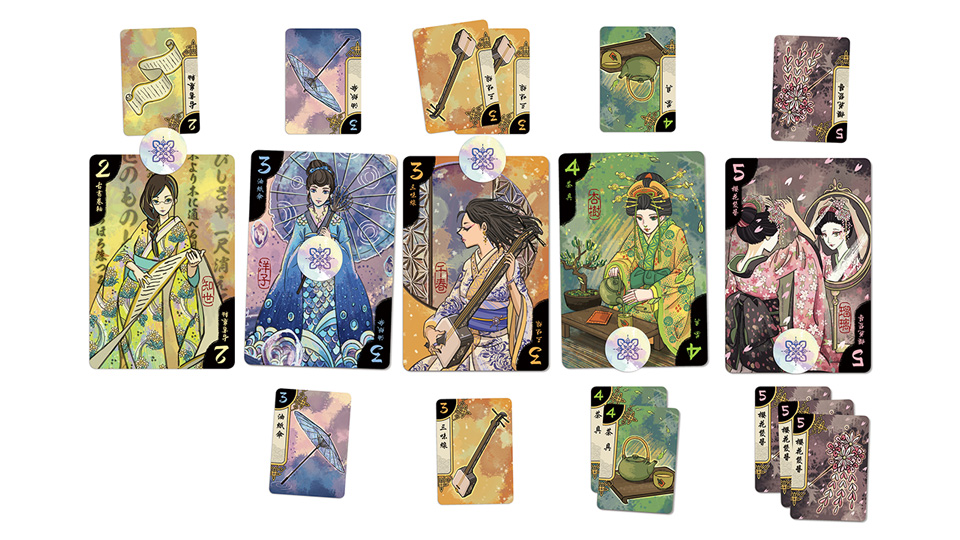Sail was one of the most unusual new games I played in 2023: a cooperative trick-taking game where you’re trying to jointly steer a ship around obstacles and sea monsters to reach the end of the path before you run out of turns or your ship takes too much damage. It’s a retheme of a Japanese game called Hameln Cave, published in a tiny box by the folks at Allplay, who specialize in publishing ‘big’ games in small boxes, including Pollen (a retheme of Reiner Knizia’s Samurai: the Card Game) and the underrated little dice-rolling game Sequioa.
Sail has a deck of cards in three suits where each number has a specific symbol on it, and the combination of symbols on the two cards played in each trick determines what happens on the map. You and your partner will each get a hand of cards, exchanging some before the first turn, and then you’ll play a series of tricks – without communicating with your partner – where you must follow suit if possible, which of course means trying to get rid of a suit and/or find a way to indicate what you have to your partner.
The map varies by game, and you can pick a scenario to suit your desired difficulty level, play through them in sequence as a campaign, or even design your own. Every map has obstacles in rocks and Kraken monsters, plus lines you must cross by the end of the Nth turn to stay in the game. You have a set number of turns to reach the finish line, the distance to which also varies by scenario. One major catch is that the spaces on the map are diamonds, so moving to an adjacent space isn’t the same as moving in a straight line, and you’ll have to try to tack back and forth to keep moving while also trying to avoid the islands and monsters. One great card combination lets you move straight to the diamond that only touches your current space at one point, but as you might imagine it’s hard to pull that off. If moving the ship would put the ship on an island or off the map, it doesn’t move at all, which results in a wasted turn.
The remaining combinations can run from the ‘not too bad’ to the ‘very bad,’ with many of them dealing damage to your ship. Cards numbered 1-3 have a Kraken symbol and when played with other cards numbered 1-3 or cards that just move your ship to an adjacent space, they damage your ship. The game begins with all cards numbered 1 or 2 in a separate Kraken deck, but those will enter the player deck any time you take damage from the Kraken. You might even take two damage if you both play a card numbered 1-3 in the same trick. You can deal damage to the Kraken, which allows you to take the lower card in the trick and discard it to the Kraken deck, improving your deck for the next round and also giving you more time, as you can lose the game when the Kraken deck is exhausted. If you both play cards with cannon symbols, you flip the next card in the deck and get something positive – moving the ship either to an adjacent space or forward, or discarding a low-numbered card to the Kraken deck.
Each round ends when one player wins their fourth trick, so you can extend rounds by trying to balance the number of tricks each player wins. When a round ends, you take damage based on where the Kraken meeple is on its board; this meeple moves up any time you take damage but the top card in the Kraken deck isn’t a numbered card but the Kraken card itself, after which you move that to the bottom of its deck and bump up the Kraken meeple so you take more damage after each round. If you ever take damage from the Kraken but there’s nothing else in its deck, you lose.
If you steer the ship on to the End Token on the map, you win immediately. As in most coop games, there are more ways to lose than to win: If you haven’t reached the End Token after 5 rounds, haven’t passed the checkpoints after rounds 2/4, exhaust the Kraken deck, or move the Kraken meeple to the final space, kindly labeled as “Dead.”
What really, really works about Sail is that it’s extremely tight – I don’t think this is a game you can ever win easily. I played this with my father, an experienced bridge player, and once we got the rhythm going, we did quite well … yet whenever we won a scenario, it was by the skin of our teeth. It made for an intense but fun gaming experience: there’s such satisfaction in pulling off the series of moves you need to win without being able to communicate. After a few rounds, we started to ‘read’ each other a bit more as well, so we could strategize without communicating, which I think is also key to this sort of game (The Mind would be the best-known example, I think).
You can buy it directly from Allplay for $1 cheaper than you’d pay on Amazon, including shipping, and you could check out Sequoia as well. I also just learned that they’re reprinting the Reiner Knizia classic Through the Desert, a top 100 game for me since I started making those lists, but which has gone out of print twice in the last decade or so. I own a copy of a prior printing but I’m excited that folks will be able to buy it later this year.





